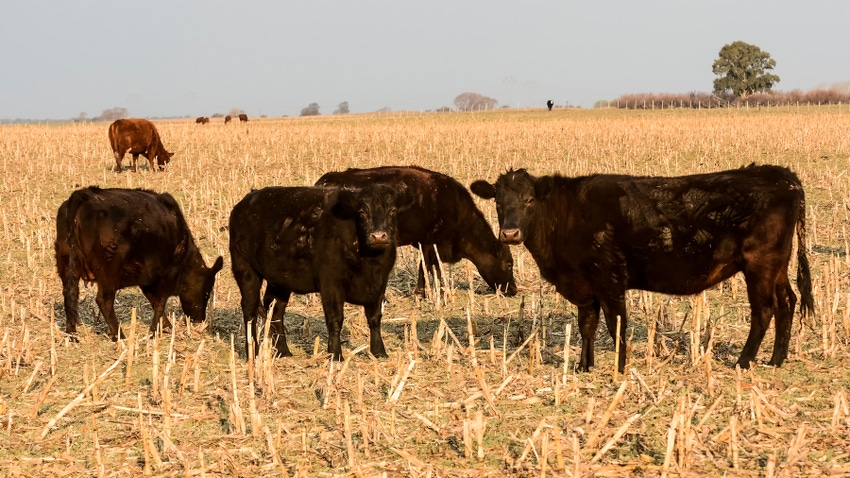September 27, 2023

by Carolyn Ihde
This year’s drought and the unknown winter forecast have many beef producers looking at corn residue to help feed the cow herd this fall and winter.
Many producers regularly use harvested cornfields as a feed source and a location to “house” the beef cow herd in the fall and early winter months, allowing the cows to graze the crop residue, rest pastures, reduce time spent in drylots or free up space in lots for weaned calves. A deeper look into corn plant components, nutritional requirements of cows and feeding options can help create a plan to optimize corn residue as feed.
When cattle are allowed to graze large areas of harvested cornfields, they travel around the allotted space and selectively eat the most appealing forages — usually grass in fence lines and waterways — while trampling some leaves and husks they could consume. They also selectively consume the leaves and husks, as these are the most palatable and nutritious parts of the corn plant. Cows seldom eat the stalks and cobs and should not be forced to, as they contain fewer nutrients and will likely reduce body condition score and body weight.
Once cows have consumed the leaves and husks, the nutritional value of the field decreases and may not be able to meet the nutritional needs of mid- to late-gestating cows and first- or second-parity females. Supplementation with corn, corn distillers or protein tubs is necessary to maintain or increase body condition.
After harvest, corn residue decreases in nutritional value over time due to degradation of the plant material. Wet weather accelerates this process. Therefore, it is vital to begin grazing fields as soon as possible after harvesting and to maintain proper stocking densities. Calculate stocking densities with this Corn Stalk Grazing Calculator.
If a producer does not have access to harvested cornfields, cannot turn cattle out before the quality of the corn residue decreases, or bad weather sets in, baling cornstalks to feed is an option. Once properly baled and stored, corn residue is protected from environmental breakdown and can be delivered to the cow herd versus bringing the cows to a cornfield.
To understand nutrient content and to meet cow needs, take a forage test to determine protein, energy and nitrate levels. There is a greater risk of high nitrates during drought, which poses a health risk to cattle. With this information, a nutritionist can help formulate a ration to meet the herd’s needs. For instance, if cows are thin due to a short supply of quality summer pastures, the ration can be developed to get cattle to the desired body condition score before females calve.
Improving palatability
Feeding baled cornstalks may take additional labor and equipment. Flail chopping before baling or grinding bales prior to feeding will increase the amount the cows consume by reducing the particle size of the stalks. Distillers grain, corn gluten, liquid protein supplements, and alternative crops and byproducts can be added to chopped or ground cornstalks for a complete ration. If equipment is unavailable for chopping, grinding, mixing, delivering and feeding a total mixed ration, adding a liquid supplement to cornstalks or low-quality Conservation Reserve Program bales is an option.
According to a 2013 study by Walker, LaMay, Davis and Bandyk, adding liquid protein to lower-quality feedstuffs reduced forage waste. However, note that the same study showed a decrease in body condition score and body weight, and the study did not test results using corn residue.
Corn residues, whether harvested by the cow via grazing or by a baler, are a way to stretch forage supplies. Take the time to perform a forage test and analyze the body condition scores of the herd to match your resources to your herd’s production stage.
Ihde is the University of Wisconsin Extension agriculture educator for Richland and Crawford counties.
Read more about:
GrazingYou May Also Like




